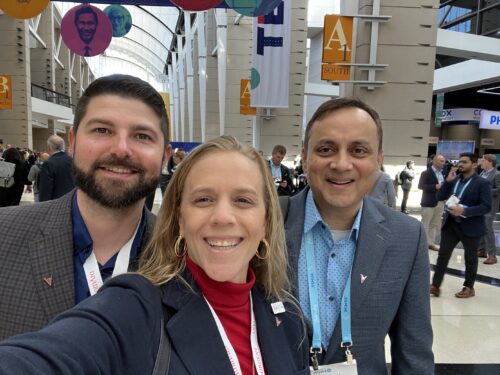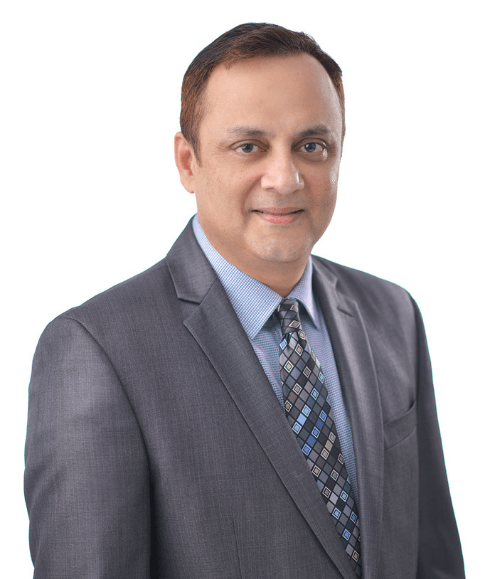Put together by the Health Information and Management Systems Society (HIMSS), their annual global health conferences are a large and highly influential health information technology event, with over 40,000 professionals in attendance, such as CIOs, providers, and IT experts. This year’s HIMSS23 conference was held in chilly Chicago, Illinois at the McCormick Place Convention Center and covered a variety of themes, including digital health transformation, telehealth, cybersecurity, and artificial intelligence (AI).
Along with HIMSS’ meaningful panels and presentations, they also foster an environment for networking and building professional relationships through hosting inclusive events of all sizes, as well as holding continued education opportunities and a space for exhibitions.



Divurgent was thrilled to have an excellent attendance from their Team that included Shane Danaher (COO), Hannah Ellerbee, Joe Grinstead (EVP), Rebecca Woods (EVP), Steve Weichhand (SVP), Christopher Kunney (SVP), Sarah Brandt (VP), Jessica Hadley (VP), Katherine Isaza (VP), Andrew Wells (VP), Golam Sayeed (Principal), and Jeff Fuller (Associate). Divurgent also proudly organized morning runs, where proceeds were given back to the Chicago community through Nourishing Hope – a non-profit organization helping Chicago residents overcome hunger, improve mental wellness, and build healthier lives for their future.
Top 3 HIMSS Conference Takeaways
Though many important topics were covered throughout the HIMSS 2023 conference, these were the top three overall takeaways:
1. Health Equity Through Interoperability
Advancing health equity through interoperability is a great way to ensure equitable access to healthcare information and services for all patients regardless of their socio-economic status, race, ethnicity, or their demographic factors. This is achievable with the use of technology and data exchanges to improve access to healthcare to reduce imbalance in healthcare outcomes for underserved populations.
Interoperability enables healthcare providers to consistently exchange patient health information across different systems, which can improve the quality of care, reduce risk of medical errors, better track patient outcomes, identify areas of improvements, and potentially customize care to meet the unique needs of each patient.
A few ways for improving health equity through interoperability are:
- Standardize health information, where health data can be shared accurately and efficiently between healthcare providers and organizations.
- Empower patients by giving them access to their own healthcare information, including medical records, test results, and treatment plans.
- Improve data privacy and security, ensuring that during the exchange of health information, privacy and security measures are in place to protect patient confidentiality, build trust, and encourage individuals to engage with interoperable systems.
Overall, while interoperability offers great promises for advancing health equity, it will require careful planning, investment, and collaboration to realize its full potential.
2. Protected Health Information to Improve AI in Healthcare
AI is beneficial for healthcare in many ways. It can improve efficiency and cost savings, improve diagnostic accuracy, as well as enhance treatment planning and personal care through remote monitoring and telemedicine, predictive analytics, research, and clinical decision support.
Protected Health Information (PHI) refers to any individually identifiable health information that is protected under the Health Insurance Portability and Accountability Act (HIPAA). PHI includes information such as a patient’s name, address, social security number, medical history, and other personal health information. The use of PHI is highly regulated to protect patient privacy and security.
Some considerations for the best usage of PHI to improve AI in healthcare are:
- Data should be anonymized or de-identified to remove personally identifiable information. This helps protect patient privacy while still allowing for the analysis of aggregated data.
- Strong security measures should be implemented to protect PHI from unauthorized access, breaches, or misuse.
- Patients should be informed about how their data will be used for AI purposes and can provide explicit consent.
- Data sharing agreements should be established to outline how PHI will be handled, ensuring compliance with privacy regulations and data protection standards.
- Usage of PHI in AI should be continuously monitored and evaluated to assess the effectiveness, accuracy, and impact of the AI systems.
- Regular audits and assessments can help identify and rectify any potential risks or shortcomings.
By following guidelines, healthcare providers can leverage PHI to improve AI in healthcare while protecting patient privacy, maintaining data security, and upholding ethical principles. It is crucial to maintain a balance between advancing AI technologies and protecting patient rights to ensure that the benefits of AI are realized without compromising patient trust and confidentiality.
3. IT Infrastructure for Secure Sharing of Clinical Data
The ability to share clinical data is needed to exchange patient health information among healthcare providers, institutions, and other authorized entities. The sharing of clinical data plays a critical role in healthcare, as it enables healthcare providers to make informed decisions about patient care, improve care coordination, and ultimately improve patient outcomes. Clinical data is usually shared via Health Information Exchange (HIE), Electronic Health Record (EHR), patient portals within healthcare providers, and telemedicine.
A strong IT infrastructure is a key component for secure sharing of clinical data. Healthcare providers rely heavily on IT infrastructure to facilitate data exchange, enable efficient communication, and ensure secure and reliable access to patient information. Below are a few reasons why and how a strong IT infrastructure is critical for secure sharing of clinical data:
- Data Integration. A strong IT infrastructure can facilitate integration of disparate data sources, enabling healthcare providers to access and share real-time data. This includes integrating various clinical systems, such as EHRs, lab information systems, and medical imaging systems.
- Data Standardization. A strong IT infrastructure can standardize data formats and ensure consistency and accuracy in data exchanges, resulting in reduced risk of errors, which could impact patient safety.
- Data Security. A strong IT infrastructure can provide robust security measures, such as encryptions, firewalls, and access controls, which will protect patient data from unauthorized access and data breaches enabling patient data privacy and trust.
- Access Control. A strong IT infrastructure can enable healthcare providers to control access to patient data, ensuring that only authorized individuals can view and share patient data. Access control mechanisms also protect patient’s privacy and complies with regulatory requirements.
- Disaster Recovery. A strong IT infrastructure can provide disaster recovery and business continuity measures, ensuring critical healthcare data can be restored quickly in the events of disaster or system failure, allowing patient care to continue uninterrupted.
Overall, a strong IT infrastructure provides the foundation for secure sharing of clinical data, protecting patient privacy, maintaining data integrity, and ensuring regulatory compliance. It plays a crucial role in establishing trust among healthcare entities, patients, and other stakeholders involved in the exchange and use of sensitive healthcare information.
About the Author

Golam Sayeed | Principal, Client Service
Golam Sayeed is a Principal of Client Service at Divurgent. He is a is an entrepreneurial & accomplished leader with extensive experience in devising strategic plans to achieve operational excellence in portfolio management, information & data security, and enterprise software development. Golam brings over 20 years of experience in demonstrating excellence of program & portfolio creation, technology programs, IT security & compliance, and cloud technology. He has developed & implemented Enterprise PMO & Portfolio Management framework & best practices for IT Infrastructure, IT Security & Operations, established foundation of constant project success throughout the organization through development of strong project management discipline and with executive leadership. To learn more about Golam, visit him on LinkedIn.


